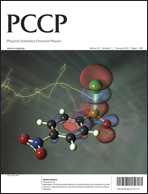Comparing coupled cluster and composite quantum chemical methods for computing activation energies and reaction enthalpies of radical propagation reactions
IF 2.9
3区 化学
Q3 CHEMISTRY, PHYSICAL
引用次数: 0
Abstract
Accurate determination of activation energies and reaction enthalpies is essential for understanding the propagation step in free radical polymerization, as it significantly affects polymer chain length and structure. In this study, we compare DLPNO-CCSD(T) to canonical CCSD(T) for 17 radical addition activation energies and 18 reaction enthalpies from Radom and Fischer’s test set. Additionally, we compare the computationally efficient composite methods G3(MP2)-RAD and CBS-RAD against CCSD(T)/aug-cc-pVTZ and DLPNO-CCSD(T)/CBS methods. Compared to the CCSD(T)/aug-cc-pVTZ reference, our results indicate that DLPNO-CCSD(T)/CBS with unrestricted Hartree-Fock (UHF) or UB3LYP reference orbitals and NormalPNO parameters consistently achieves chemical accuracy, with mean absolute deviations of 3.5 kJ/mol for activation energies and 1.5 kJ/mol for reaction enthalpies. Comparing the two composite methods shows that CBS-RAD agrees most closely with coupled cluster reaction enthalpies, while G3(MP2)-RAD tracks the activation energies most closely.比较计算自由基传播反应活化能和反应焓的耦合簇和复合量子化学方法
准确测定活化能和反应焓对于了解自由基聚合的传播步骤至关重要,因为这对聚合物链的长度和结构有重大影响。在本研究中,我们比较了 DLPNO-CCSD(T) 和典型 CCSD(T) 对 Radom 和 Fischer 测试集中 17 种自由基加成活化能和 18 种反应焓的测定结果。此外,我们还将计算效率高的复合方法 G3(MP2)-RAD 和 CBS-RAD 与 CCSD(T)/aug-cc-pVTZ 和 DLPNO-CCSD(T)/CBS 方法进行了比较。与 CCSD(T)/aug-cc-pVTZ 参考相比,我们的结果表明,DLPNO-CCSD(T)/CBS 使用非限制哈特里-福克 (UHF) 或 UB3LYP 参考轨道和 NormalPNO 参数,始终保持了化学准确性,活化能的平均绝对偏差为 3.5 kJ/mol,反应焓的平均绝对偏差为 1.5 kJ/mol。比较两种复合方法发现,CBS-RAD 与耦合团簇反应焓的吻合度最高,而 G3(MP2)-RAD 与活化能的吻合度最高。
本文章由计算机程序翻译,如有差异,请以英文原文为准。
求助全文
约1分钟内获得全文
求助全文
来源期刊

Physical Chemistry Chemical Physics
化学-物理:原子、分子和化学物理
CiteScore
5.50
自引率
9.10%
发文量
2675
审稿时长
2.0 months
期刊介绍:
Physical Chemistry Chemical Physics (PCCP) is an international journal co-owned by 19 physical chemistry and physics societies from around the world. This journal publishes original, cutting-edge research in physical chemistry, chemical physics and biophysical chemistry. To be suitable for publication in PCCP, articles must include significant innovation and/or insight into physical chemistry; this is the most important criterion that reviewers and Editors will judge against when evaluating submissions.
The journal has a broad scope and welcomes contributions spanning experiment, theory, computation and data science. Topical coverage includes spectroscopy, dynamics, kinetics, statistical mechanics, thermodynamics, electrochemistry, catalysis, surface science, quantum mechanics, quantum computing and machine learning. Interdisciplinary research areas such as polymers and soft matter, materials, nanoscience, energy, surfaces/interfaces, and biophysical chemistry are welcomed if they demonstrate significant innovation and/or insight into physical chemistry. Joined experimental/theoretical studies are particularly appreciated when complementary and based on up-to-date approaches.
 求助内容:
求助内容: 应助结果提醒方式:
应助结果提醒方式:


